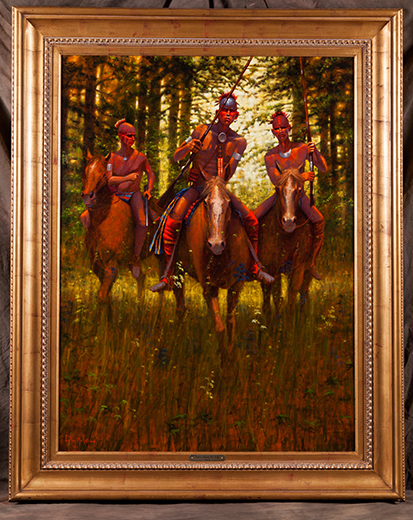
Eastern Shawnee War Party - Original Oil Painting

The Story of the Red Coat - Original Oil Painting

Treetop Advantage - Original Oil Painting

One Step at a Time - Giclée Print

Straight as an Arrow - Giclée Print

A Quick Glance - Giclée Print

Smokin' Out the Den Tree - Giclée Print

Slippery Rock Falls - Giclée Print

Broken Silence - Giclée Print

Battle Ready - Giclée Print

The Painted Tree - Giclée Print

Hawkeye - Giclée Print

Native American Symbols
Symbols were universal on the early frontier, understood by Indians and frontiersmen as a way of communication. Often times the bark was cut away from the tree leaving an area to paint the symbols. These symbols were also used to create maps or generate warnings for the next traveler. These symbols come from "The Painted Tree" by Doug Hall and signify: We are armed, This is our boundry and We will defend.

Spopeia and Mameia
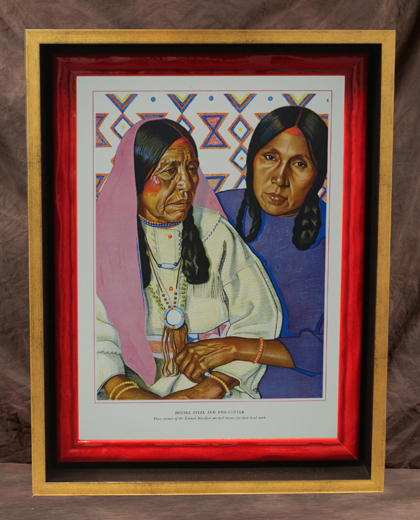
Double Steel and Two Cutter

Morning Gun

Jim Blood

Short Man

Many Horses, Little Rosebush and Baby

Clears Up

Morning Bird

Juniper Buffalo Bill and Little Young Man
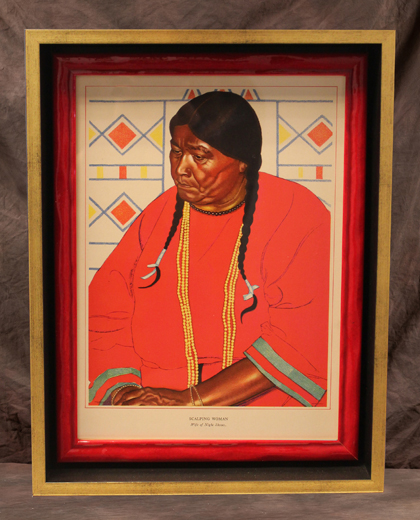
Scalping Woman

Singing in the Clouds

I Am Crow
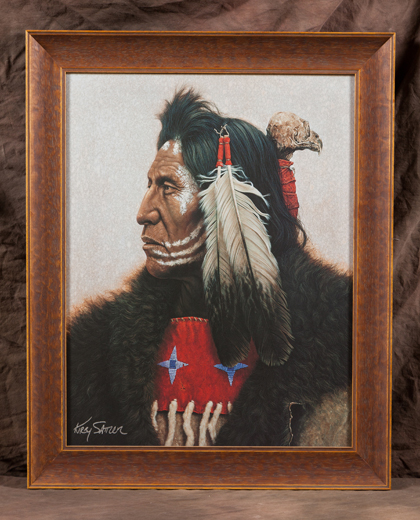
Two Stars

Red Path

Bird of Prey

Blue Fire

Before the Council

Ghost of the Plains Horse

Lakota Water Maidens

Sitting Bull
Photograph

Geronimo
Photograph

Three for the Road - Original Oil Painting

Custer's Last Fight

Freedom Walker - Photo On Tapestry

Redskin - Movie Poster

Embossed Indian Chief

Shadows of Bowhunting Look Carefully

Reflections of Bowhunting Look Carefully

The Plainsman - Giclée Print

Whatever You Shoot
Tin Advertising Sign

Shotguns and Duck
Tin Advertising Sign

For Rifles and Pistols
Tin Advertising Sign

Winchester Western Rifle Deer Poster (1950)

Winchester Western Rifle Pheasant Poster (1955)

Goose Hunting Poster
"Take 'Em"
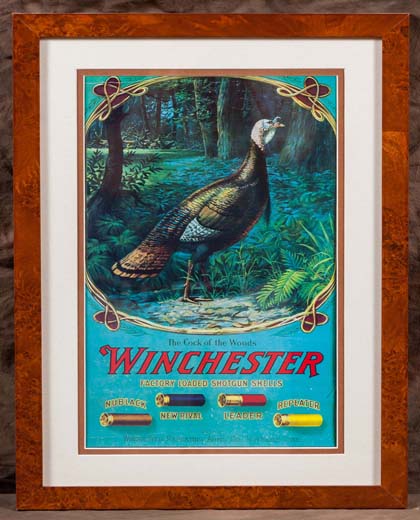
Cock of the Woods
Tin Advertising Sign

Winchester Rifles & Ammunition
Tin Advertising Sign

Colt Revolvers
Tin Advertising Sign

Smith & Wesson Revolvers
Tin Advertising Sign

Smith & Wesson Revolvers
Tin Advertising Sign
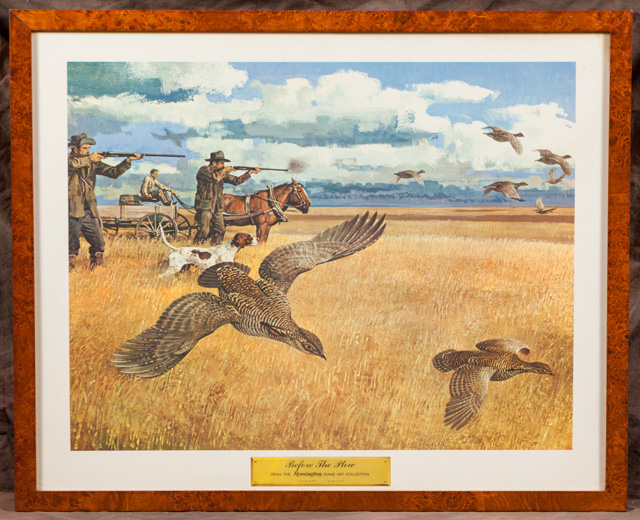
Before The Plow
Tin Advertising Sign
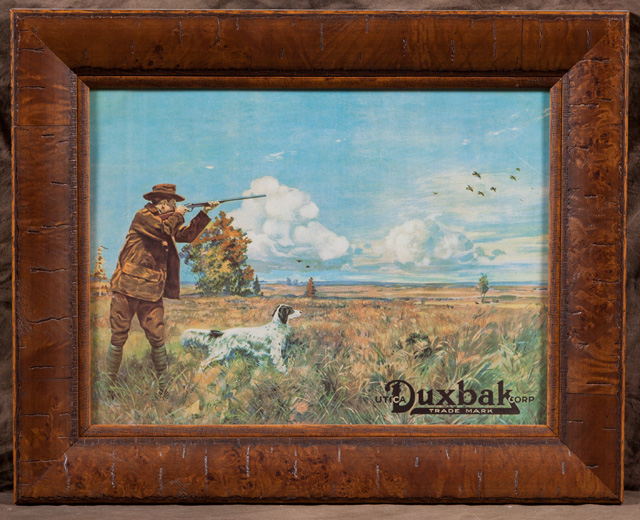
Duxbak Firearms
Tin Advertising Sign

Field and Stream: November 1927
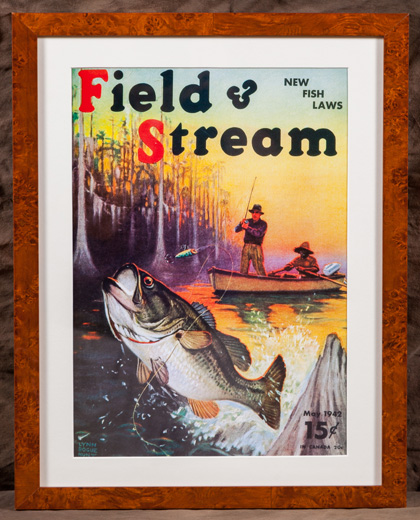
Field and Stream: May 1942

Field and Stream: September 1929
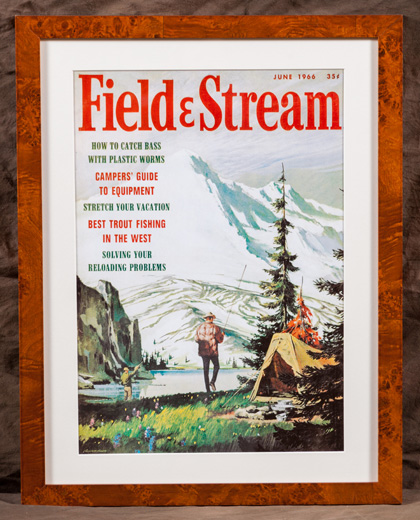
Field and Stream: June 1966

First to Fight
World War I Recruiting Poster

Be A Sea Soldier
World War I Recruiting Poster

Davess Holdings Safe - Circa 1840

Coffee & Fox Safe - Circa 1860
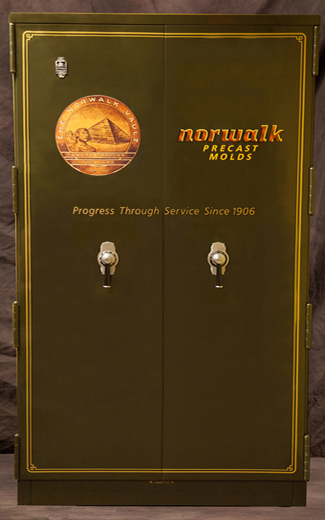
Norwalk Precast Molds Safe - Circa 1940

Mare & Foal Standing in Meadow

Bugling Elk
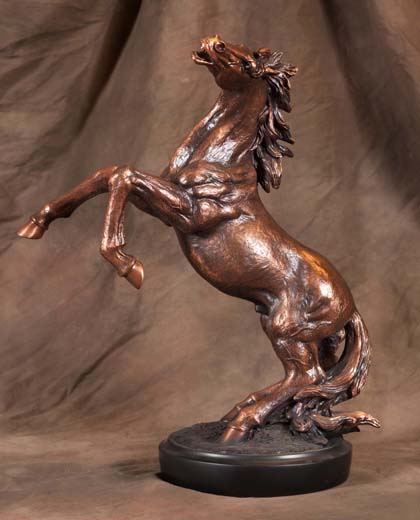
Rearing Horse
Bronze on Marble

Cheyenne

Death Battle
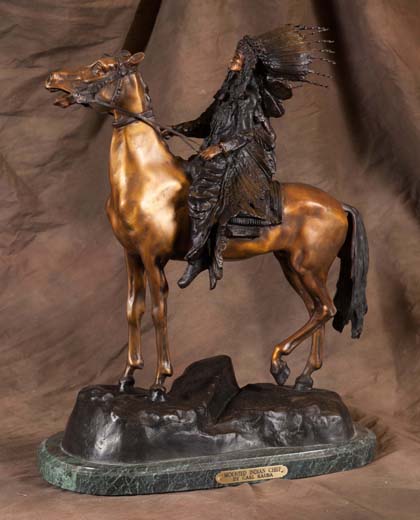
Mounted Indian Chief

How Kowla

End of the Trail

Buffalo Horse

Horsethief

Vigil

War

War Party

Scalp

Indian With Drums

Lassoed Mustang
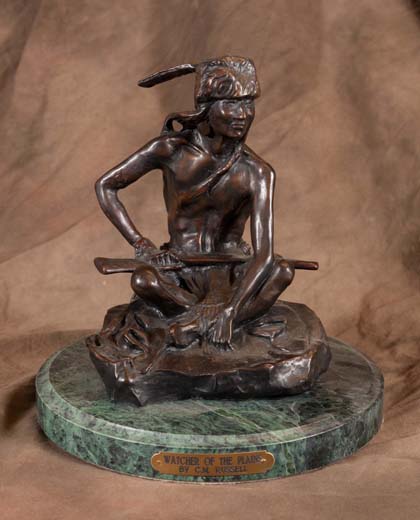
Watcher of the Plains
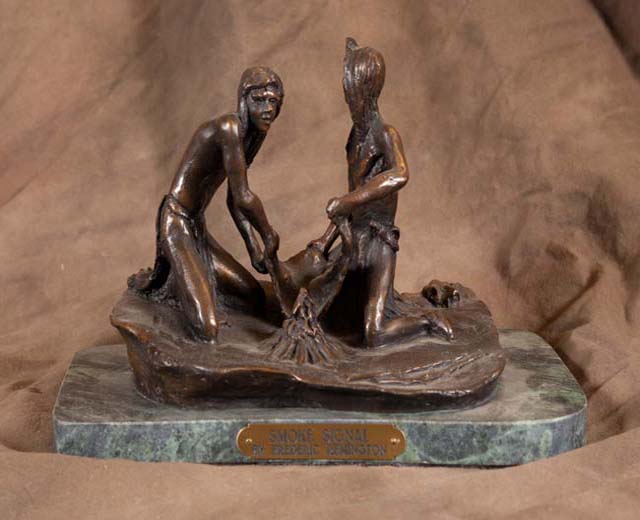
Smoke Signal

Buffalo Hunt

Buffalo Signal
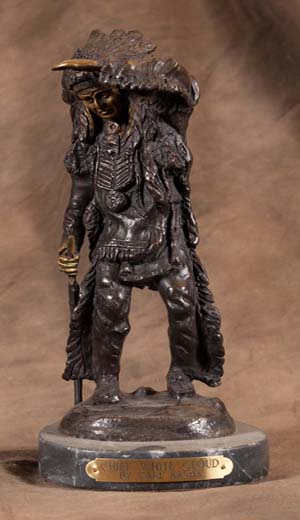
Chief White Cloud
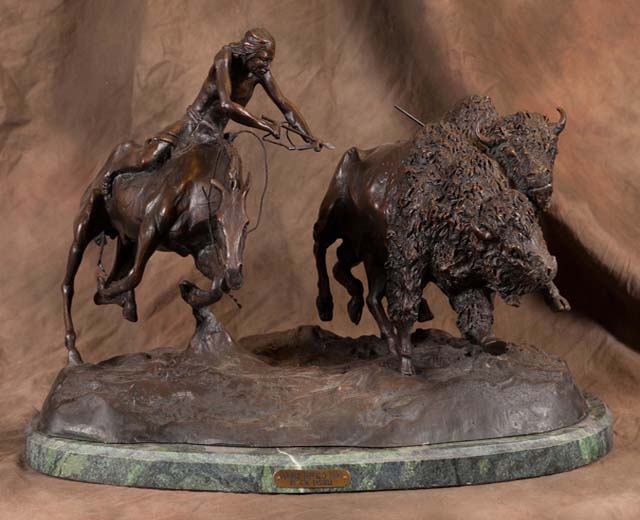
Double Buffalo Hunt

Silent Thunder

Calling The Buffalo

Buffalo
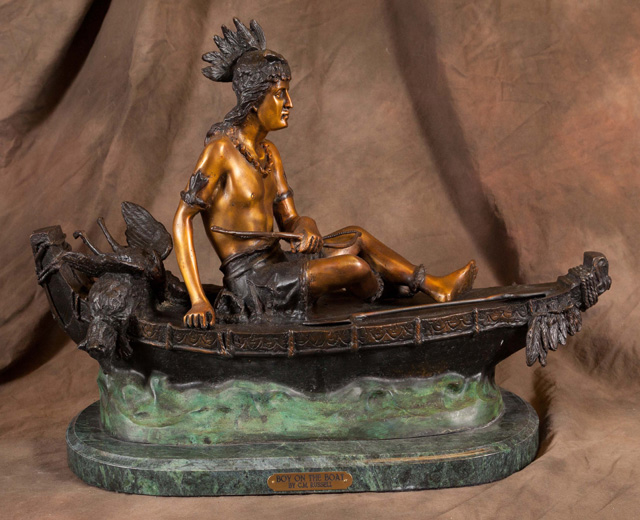
Boy On The Boat

The Norwalk Vault Seal
Original logo of our founding company. Over a century old, the Norwalk Vault Company established patents on burial vault molds beginning in 1902.
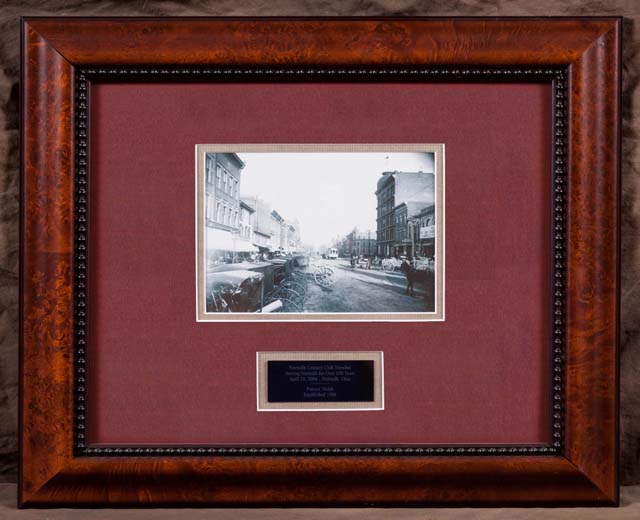
Norwalk Century Club
Presented to Norwalk Precast Molds in recognition of 100 years of service to our Community.
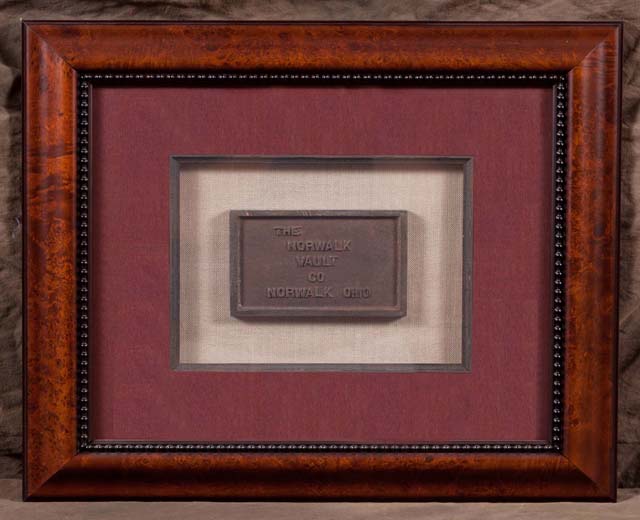
Original Norwalk Vault Co. Cast Iron Name Plate
Used on burial vaults in the 1900's.
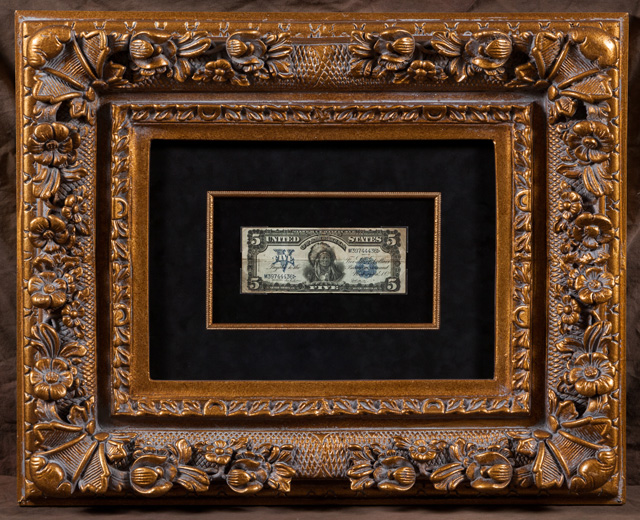
1899 Chief One Pappa $5 Silver Certificate
Features Sioux Indian chief, Ta-to-ka-in-yan-ka. The chief refused to wear his war bonnet for the portrait, so a war bonnet from the opposing Pawnee Nation was substituted, causing ill will between the Sioux and Pawnee peoples.

1901 $10 Red Seal Bison Note
This 1901 $10 Note features an American Bison and two famous American explorers, Meriwether Lewis & William Clark. It was circulated during the 100 year anniversary of the Lewis & Clark Expedition. Bison notes were printed until the early 1920's.

Indian Arrowhead Collection
Arrowheads (points) were tools used by many ancient people. Native Americans crafted numerous types of points for various uses.

Indian Arrowheads
Points were vital to almost all of the Native American tribes. The art of making arrowheads was something all of the American Indian boys would learn as children. Arrowheads had different uses and foremost they were used for hunting.
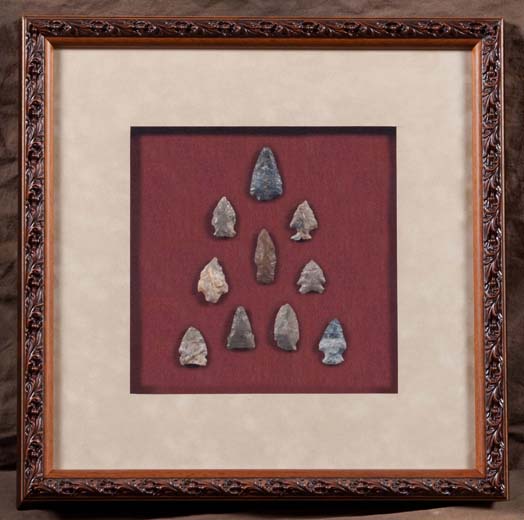
Indian Arrowheads
Arrowheads hold great historical significance and provide valuable insight to long-gone cultures. Native Americans designed many arrowheads, with 1,200 different types on record.

Indian Arrowheads
Native Americans made arrowheads using a chipping process called knapping. After the flint was removed from the quarry, the large piece was reduced by a blow to the edge with a piece of hard stone. The piece was then pressure chipped using a sharpened deer or elk antler to finely chip the edge until sharp.

Indian Arrowheads
After an arrowhead was sharp, it was fitted with a handle or hafting. The shaft then usually split and the point inserted.

Indian Arrowhead Collection (From Huron County, Ohio)
Arrowheads, or projectile points are one of the most recognizable Native American artifacts. They hold great historical significance & provide valuable insight to past cultures.
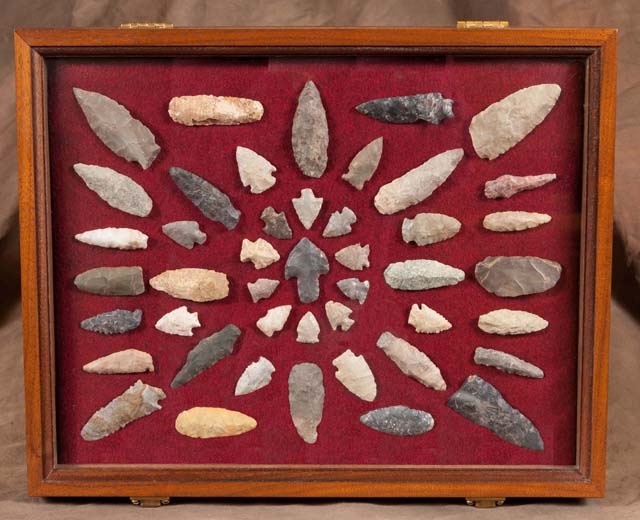
Indian Arrowhead Collection (From Ottawa County, Ohio)
Location stands as the most definitive indicator of an arrowhead type. Specific types of arrowheads may be found only in certain regions.

Indian Arrowhead Collection (From Erie County, Ohio)
The material from which an arrowhead was crafted is an important classification tool. Knowing the material significantly helps determine where a point originated.

Indian Arrowhead Collection (From Sandusky County, Ohio)
When classifying arrowheads, the shape of the base is first noted, followed by its overall shape and design. There are 6 base shapes and 10 basic categories for overall shape. Notches and fluting are also indicative of an arrowheads type and age.

Pottery Shards
Pottery shards are broken fragments of pottery. Pottery shards are important to archaeologists because they usually present in large numbers and are sensitive to time and areal differences.
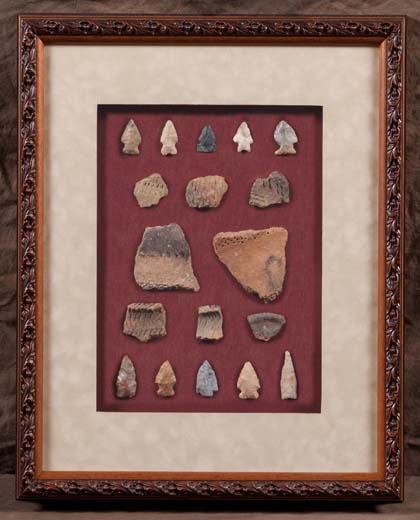
Pottery Shards
Pottery shards display different characteristics such as the variations in color, thickness, hardness, tempering material and decorative treatment. Various characteristics change through time and space, and specific characteristics may be associated with certain areas and certain time periods.

Grooved Stone Axe
Originating during the Archaic period, stone axes have been used as tools and ritual objects. Axes were grooved, either completely around the four faces of the tool, or on three of the four faces. These groove patterns give rise to the terms "full" and "threequarter" grooved axes.

Indian Rocks
Early humans did not have many materials available. Materials available were trees, rocks and minerals. Rocks have a wide variety of use from crushing wild grains to produce flour or being fashioned into weapons.
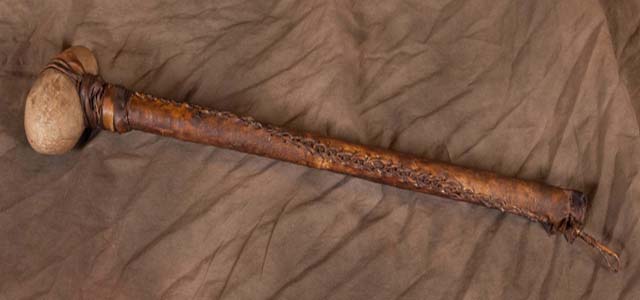
Stone War Club
War clubs encompass a wide variety of weapons used by the different tribes of Native Americans.

My Best Friend

Mutual Affection

Indian Girl with Horse

Faithful Friends

Appeal to the Great Spirit

Native American Indian Bookend
Manufactured by the W.D. Allen Mfg Co., in Chicago, Illinois.

Ohio Match Co. Chalkware Native American Reclining with Pipe

Universal Statuary Corp 1966 Native American Bust

Native American Knives
Early Native American knives were made of sharpened stone, particularly flint and obsidian. Copper knives were also popular Native American weapons.
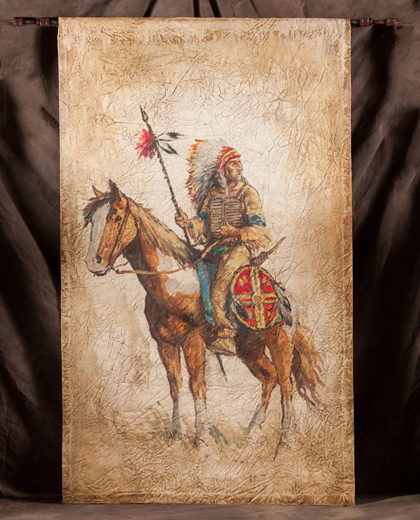
Native American Horseback Tapestry
After the Spanish settlers arrived, the Native Americans started using horses for transportation. The horse made the lives easier and hunting buffalo became much simpler.

Black Columbia River Gourd On Wooden Sun Cook Board
Columbia River region, gourds are dried, painted & hand decorated.

Spice Columbia River Gourd On Wooden Sun Cook Board
Gourds are dried, painted and decorated. Each is a one-of-a-kind work of art.

From The Forge Of Freedom, Wild Spirits Soar Bald Eagle

From the Hearts of the Fierce, Comes Peace Red Tailed Hawk

Avid Angler Osprey - AKA "Fish Hawk"

Bronze Hunting Dog, Labrador at the Ready
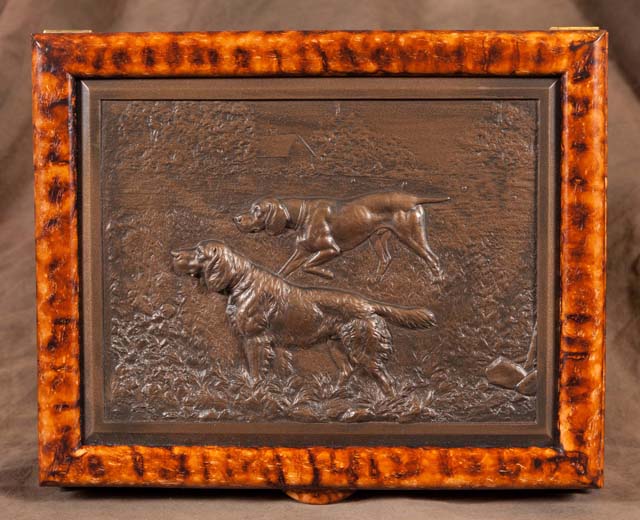
Hunting Dog Box
Designed with bronze and carved wood, the lid features a pair of bird dogs on point.

Two Hunting Dogs: Setter vs. Retriever

Watchful Vienna Bronze Fox
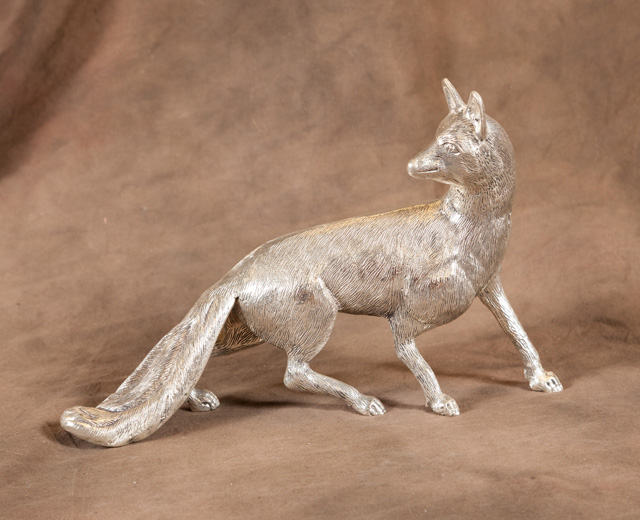
Silver Fox
Handmade in England, the silver fox captures the likeness of a sly fox with remarkable detailed features and texturing.

Eagle

Bronze Hen Pheasant
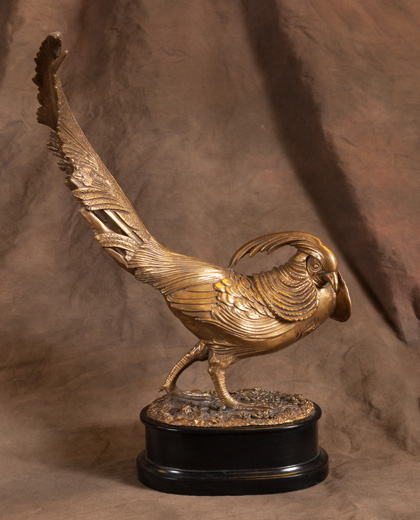
Bronze Cock Pheasant

Sir Winston Churchill Pig
Engraved with the quote "I like pigs: cats look down on human beings, dogs look up to them, but pigs just treat us as their equals" from Winston Churchill.

Jack London's Wolf White Fang
A wolf with the quote "It was the long wolf-howl, full-throated and mournful, the first howl he had ever uttered" from Jack London's novel White Fang.
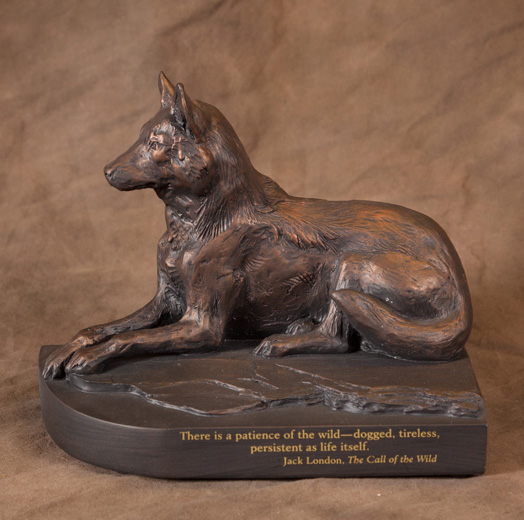
Jack London's The Call of the Wild
Wolf with the quote "There is a patience of the wild - dogged, tireless, persistent as life itself" from Jack London's novel Call of the Wild.
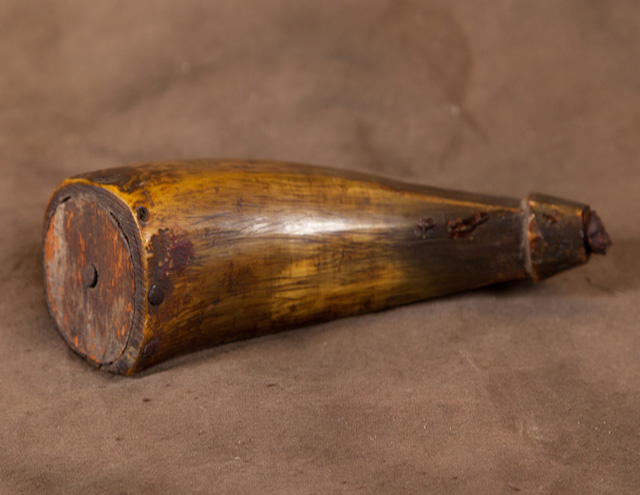
Shot Horn
A shot horn is a container for gunpowder / shot, created from cow, ox or buffalo horn. An original American art form, they vary from crude carvings to elegant scrimshaw, depicting scenes from nature, maps and history. Typically these have a stopper at both ends and are held by a long strap.

Double Deer Skull
Found in Northern Michigan, locked in a battle until death. Antlers are found on all members of the deer family (Cervidae) including deer, elk, caribou and moose. Antlers are true bone and composed primarily of calcium and phosphorus. Each year, antlers are dropped or shed and grown anew. Antler sizes are determined by three factors, age, nutrition and genetics.

Marine Devil Dog Tribute Colt .45 Pistol
Honoring the fighting spirit of the U.S. Marines and the enduring mascot of America's military brotherhood: The Marine Devil Dog. This pistol is decorated in a sparkling 24-karat gold over a handsome blued steel background, capturing the Marine's time honored spirit of camaraderie & devotion.

USMC Silver Tribute To The Armed Forces Limited Edition
This limited edition Colt .45 pistol was selected to honor each of our Armed Forces. The Colt Silver Tribute is polished and plated with beautiful, yet heavy-duty, Nickel plating. This pistol is honoring the Marine Corps with a custom checkered Rosewood grip.

USMC Golden Tribute To The Armed Forces Limited Edition
The Colt .45 best embodies the spirit of those who served in the 20th Century, being actively used from 1911 - 1985. This limited edition Colt .45 pistol pays tribute and honors the Marine Corps. The Golden Tribute is polished and plated with 24-Karat Gold.

Colt 1860 Revolver
This Colt 1860 .44 caliber is a black powder revolver with brass frame, nickel barrel and cylinder and is all fully engraved. The grey felt lined walnut display case holds all the items needed to fire this revolver including caps, balls, bullet mould and powder flask.

Colt 1861 Cap & Ball Revolver
This Colt 1861 Cap and Ball is a black powder revolver with a round barrel, a 6-shot cylinder and walnut piece grip. The grey felt lined walnut display case holds all the items needed to fire this revolver including caps, balls, bullet mould and powder flask.

Frank Wesson .22 LR
Frank Wesson rifles were a series of single shot rifles manufactured in the late 1800's in Worcester, Massachusetts. During the American Civil War many state governments purchased these rifles. They were the first rifles to use rimfire metallic cartridges.

J. Stevens .32 Caliber Rimfire
The rimfire principal was used to create the first successful self-contained metallic ammunition. Rimfire cases were constructed with the priming compound spun inside the rim of the copper or brass case, which was crushed by the blow of the firing pin to ignite the main powder charge

J. Stevens .32 Caliber Rimfire
The first rimfire cartridges were .22s, but after the type became established many larger caliber rimfire cartridges were developed in the mid to late 19th Century. The best known larger caliber rimfires are the .25 Stevens, .32 Long and .44 Henry Flat.
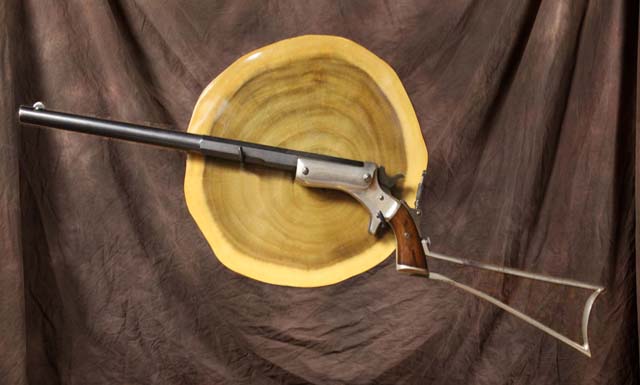
J. Stevens .32 Caliber Rimfire
Manufacturers in the USA generally discontinued making .32 rimfire ammunition after the country's entrance into WWII in 1941. During its lifetime, the .32 rimfire was loaded with black powder followed by semi-smokeless and smokeless powder loadings.

H & R "Handy Gun" Single Shot Top Break Pistol
In 1871, Gilbert Harrington invented the shell-ejecting revolver. For the first time, a firearm was durable and accurate. Teaming up with William Richardson, they created Harrington & Richardson, known for their high-quality, superior revolvers and shotguns.
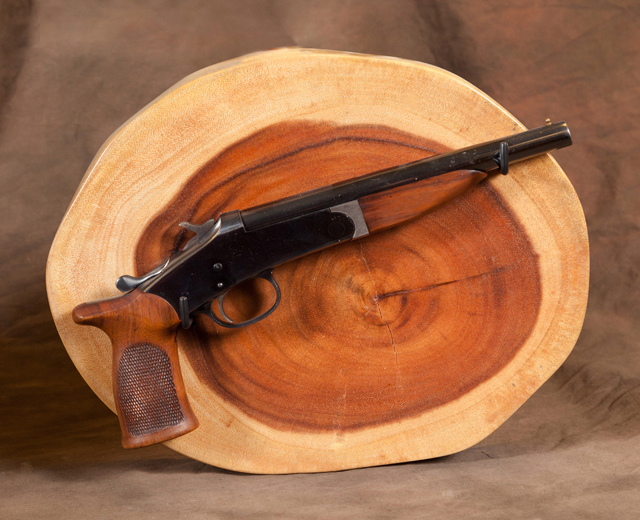
H & R "Handy Gun"
Harrington and Richardson built a state-of-the-art factory in Worcester, MA. In 1932, the H&R pistol was used to set a new U.S. pistol record, and would go on to become the most famous firearm of its kind, the U.S.R.A. single-shot target pistol.

H & R "Handy Gun" Single Shot Top Break Pistol
Produced in the 1920's and 30's, the Handy Gun was marketed as a cheap and effective way of dealing with varmints. It has an 8" long round barrel, fitted with a smooth forearm & checkered pistol grip stock, with a finger rest trigger guard and color case hardened receiver.

H & R "Handy Gun" Single Shot Top Break Pistol
Firearms produced by Harrington & Richardson until 1911 carry an extreme value as original antiquities. Original rifles and shotguns from these dates are scarce because of their limited production and discontinued parts.
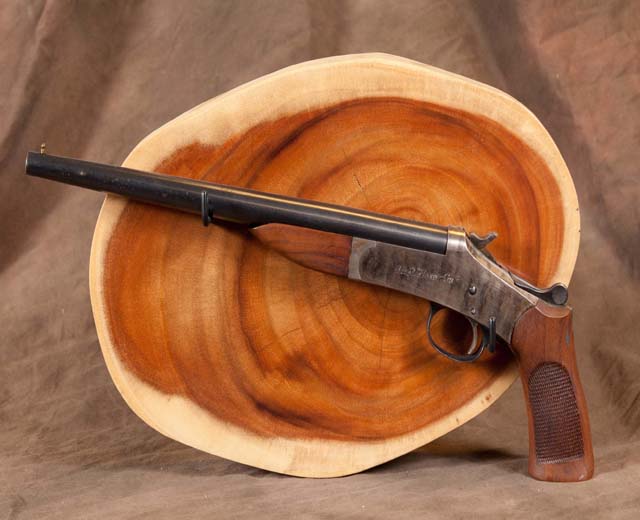
H & R "Handy Gun" Pistol
Over the years, H&R Company experienced success and was in business for over a century. However, in 1986 the company closed and the factory was demolished. In 1991, a new company, H&R 1871 was formed and they produce rifles and shotguns using original H&R designs.

Thunder at Little Big Horn
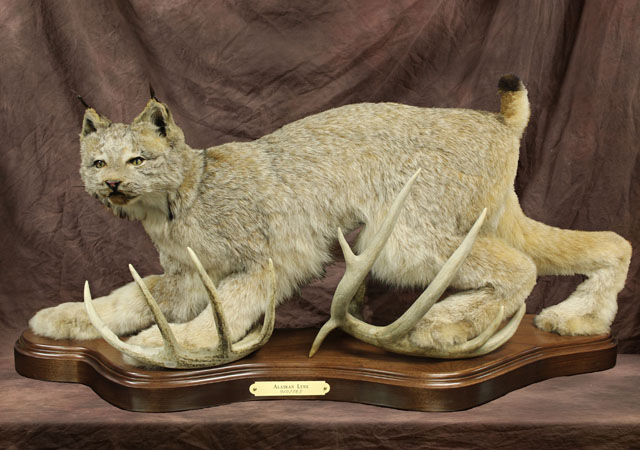
Alaskan Lynx #9102565
By James Gang Taxidermy

Bugle & Tassel
The bugle is one of the most effortless brass instruments, with no valves or other pitch altering devices. The bugle tassel is generally around the lower part of the bugle tubing.

United States Marine Corps Sergeant Bronzed Military Boots
Original military boots worn by Marine Corps enlisted men during the early Vietnam Era.
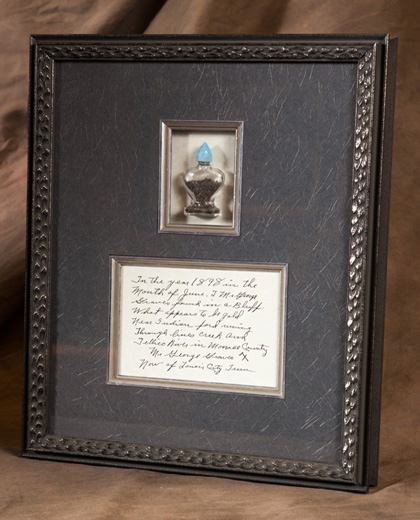
Fool's Gold
Fool's Gold or iron pyrite is a brassy yellow mineral that is often mistaken for gold. At one time, pyrite was commercially mined as a source for sulfur. In what appears to be gold, this pyrite was found near Indian Ford running through Line's Creek and the Tellico River in Monroe County, Tennessee.

John Deere Knife Collection
The John Deere Knife Collection features 14 varieties of knives ranging from a single blade pocket knife to a green bone pocket knife with three blades. This collection is from W.R. Case & Sons Cutlery Company. Founded in 1889 by four brothers, W.R. Case & Sons Cutlery Company is an American manufacturer of premium, hand-crafted knives that are passed down for generations.

Ducks Unlimited - Tin Sign
In 1937, a small group of conservationists realized that the majority of North America's waterfowl breed in the Canadian prairies, so they organized to raise money in the United States for waterfowl conservation in Canada. It was this unique idea that became Ducks Unlimited. Since 1937, Ducks Unlimited has conserved more than 14 million acres of waterfowl habitat across North America.

Patent
Our patent protected technologies record the advancements we have made in our industry throughout the history of our company operations.
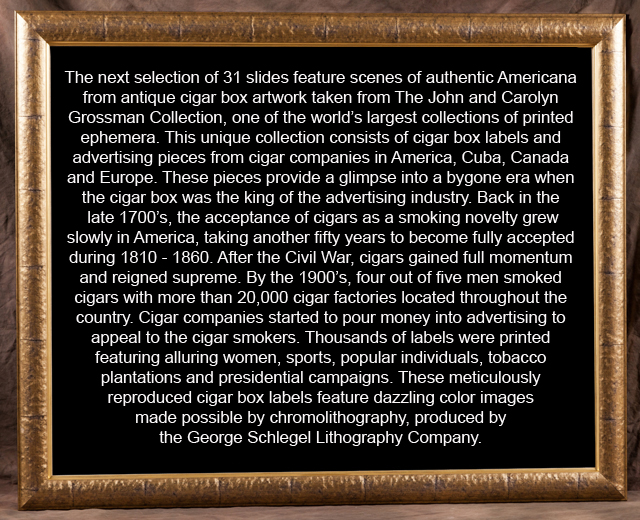
Cigar Box Art
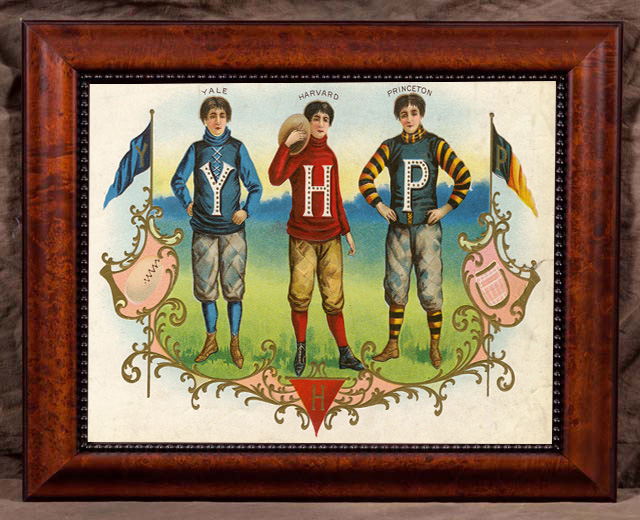
Y.H.P.

College Days
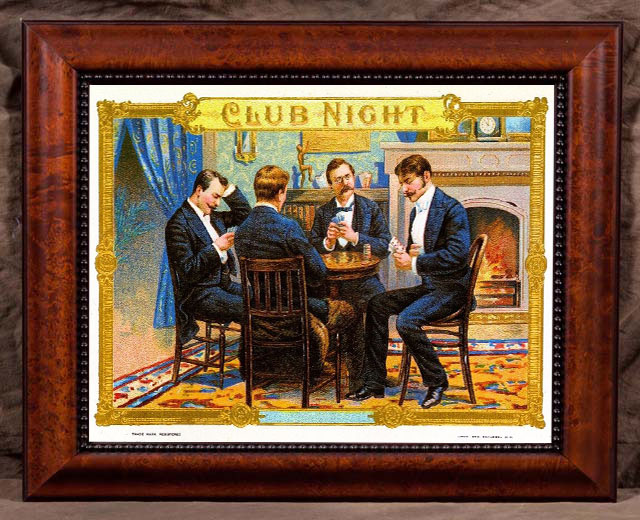
Club Night

Fancy Shot

The Bat

Hans Wagner
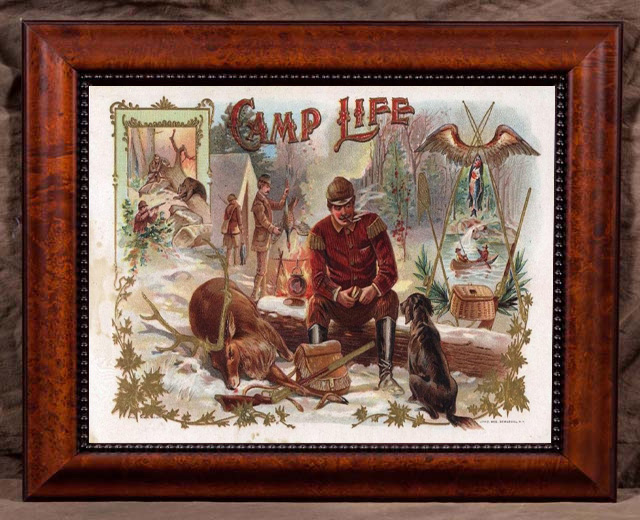
Camp Life

The Marksman

Fishing Line

Squaretail

U.S. Club House

Trade Winds

Over Sea

Aero

Dayton Flyer

Fire Chief

Bull Durham
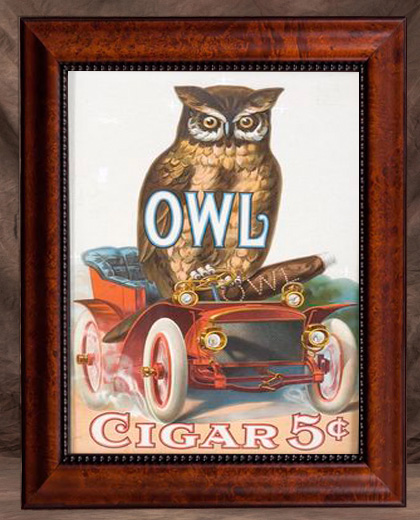
Owl Cigar

King Moose

Tampa Fad

Telonette Cigars
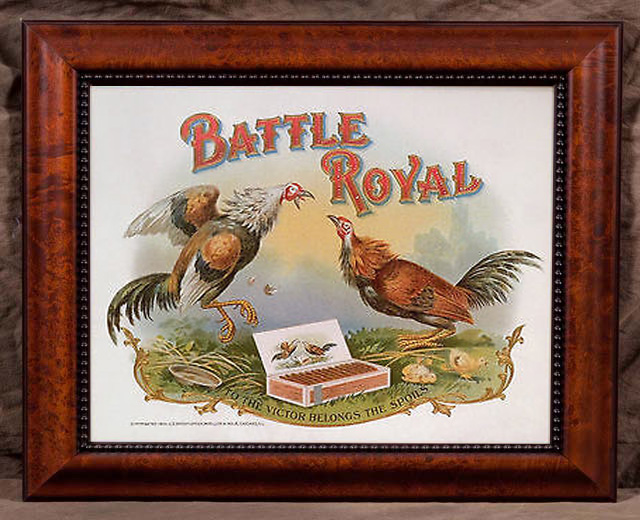
Battle Royal

Gopher

Greetings to Dad

Butterfly

Holy Moses

Jolly Monk

Solid Shot

Sweet Liberty

Operator

Our Next Door Neighbor

205 Industrial Parkway Norwalk, Ohio, U.S.A. 44857-1156
Phone: (419) 668-1639 Fax: (419) 668-9156 |
SITEMAP

